Internal Control and Asset Management
VerifiedAdded on 2020/04/07
|9
|2034
|173
AI Summary
This assignment focuses on evaluating the effectiveness of internal control systems within a company concerning asset management. It requires analyzing procedures for purchasing, disposing of assets, and maintaining accurate records. The task involves checking registers, invoices, approval processes, and reconciliation statements to identify potential deficiencies and recommend improvements.
Contribute Materials
Your contribution can guide someone’s learning journey. Share your
documents today.

AUDIT THEORY
Secure Best Marks with AI Grader
Need help grading? Try our AI Grader for instant feedback on your assignments.

Audit
Contents
Answer-1.....................................................................................................................................................2
Strengths of internal control of the acquisition...........................................................................................2
i. Proper approvals-................................................................................................................................2
ii. Delegation of duties-...........................................................................................................................2
iii. Proper recording of transaction-.........................................................................................................3
iv. No misuse of asset-..............................................................................................................................3
v. Updation of registers-..........................................................................................................................3
vi. Monthly reconciliations-......................................................................................................................4
vii. Appropriate calculation of depreciation-.........................................................................................4
Answer-2.....................................................................................................................................................5
Procedures for testing the internal control of the system...........................................................................5
2
Contents
Answer-1.....................................................................................................................................................2
Strengths of internal control of the acquisition...........................................................................................2
i. Proper approvals-................................................................................................................................2
ii. Delegation of duties-...........................................................................................................................2
iii. Proper recording of transaction-.........................................................................................................3
iv. No misuse of asset-..............................................................................................................................3
v. Updation of registers-..........................................................................................................................3
vi. Monthly reconciliations-......................................................................................................................4
vii. Appropriate calculation of depreciation-.........................................................................................4
Answer-2.....................................................................................................................................................5
Procedures for testing the internal control of the system...........................................................................5
2

Audit
Answer-1
Strengths of internal control of the acquisition
The strengths of internal control of the acquisition and disposal of tangible non-current assets of
B Ltd are as follows:
i. Proper approvals-
The company has its departments and every department is managed by a designated
manager who raises his request for purchase of a new asset in a purchase requisition
form. This form is then checked by the purchasing officer. If the purchasing officer
finds the request as valid, he acknowledges and approves the same and then sends it
to the finance department. This is a great procedure followed by the company which
follows two stages of approval- first by the departmental manager and then by the
purchasing department (Coram et. al, 2011). Hence, when the process moves through
a two-way step then it is easy to check and verify the entire matter. Moreover, in such
cases, the chances of deviations are less.
ii. Delegation of duties-
The financial accountant then approves the acquisition of assets of over $5,000 but up
to $10,000 only. Beyond $ 10,000 purchase is approved by the board of directors
only. In absence of any information, the assets costing less than $5,000 is assumed to
be approved by the financial accountant only. This reduces the burden of the board of
directors to some extent. As the accountant is concerned with the financial data so the
onus of the approval resides with him and not the board of directors.
3
Answer-1
Strengths of internal control of the acquisition
The strengths of internal control of the acquisition and disposal of tangible non-current assets of
B Ltd are as follows:
i. Proper approvals-
The company has its departments and every department is managed by a designated
manager who raises his request for purchase of a new asset in a purchase requisition
form. This form is then checked by the purchasing officer. If the purchasing officer
finds the request as valid, he acknowledges and approves the same and then sends it
to the finance department. This is a great procedure followed by the company which
follows two stages of approval- first by the departmental manager and then by the
purchasing department (Coram et. al, 2011). Hence, when the process moves through
a two-way step then it is easy to check and verify the entire matter. Moreover, in such
cases, the chances of deviations are less.
ii. Delegation of duties-
The financial accountant then approves the acquisition of assets of over $5,000 but up
to $10,000 only. Beyond $ 10,000 purchase is approved by the board of directors
only. In absence of any information, the assets costing less than $5,000 is assumed to
be approved by the financial accountant only. This reduces the burden of the board of
directors to some extent. As the accountant is concerned with the financial data so the
onus of the approval resides with him and not the board of directors.
3
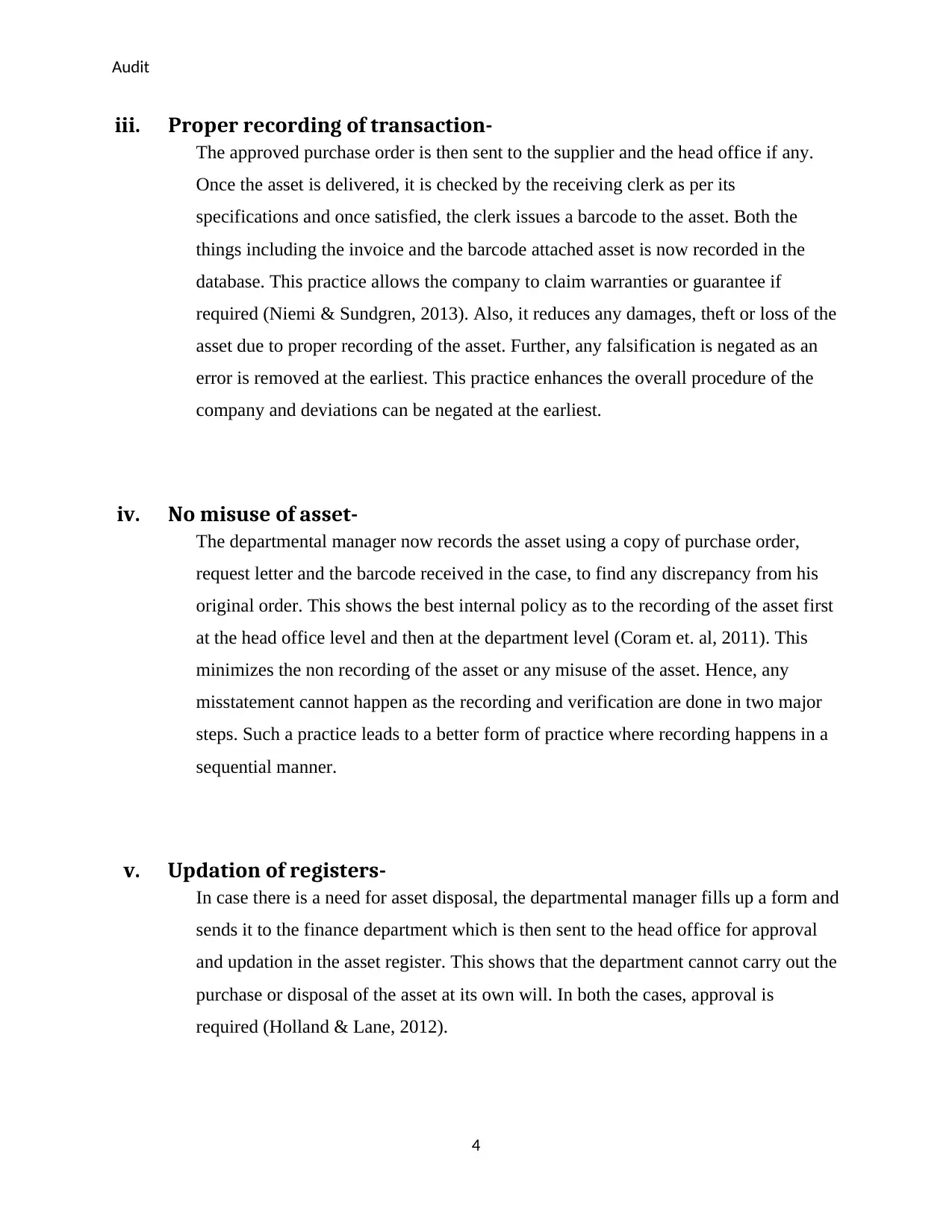
Audit
iii. Proper recording of transaction-
The approved purchase order is then sent to the supplier and the head office if any.
Once the asset is delivered, it is checked by the receiving clerk as per its
specifications and once satisfied, the clerk issues a barcode to the asset. Both the
things including the invoice and the barcode attached asset is now recorded in the
database. This practice allows the company to claim warranties or guarantee if
required (Niemi & Sundgren, 2013). Also, it reduces any damages, theft or loss of the
asset due to proper recording of the asset. Further, any falsification is negated as an
error is removed at the earliest. This practice enhances the overall procedure of the
company and deviations can be negated at the earliest.
iv. No misuse of asset-
The departmental manager now records the asset using a copy of purchase order,
request letter and the barcode received in the case, to find any discrepancy from his
original order. This shows the best internal policy as to the recording of the asset first
at the head office level and then at the department level (Coram et. al, 2011). This
minimizes the non recording of the asset or any misuse of the asset. Hence, any
misstatement cannot happen as the recording and verification are done in two major
steps. Such a practice leads to a better form of practice where recording happens in a
sequential manner.
v. Updation of registers-
In case there is a need for asset disposal, the departmental manager fills up a form and
sends it to the finance department which is then sent to the head office for approval
and updation in the asset register. This shows that the department cannot carry out the
purchase or disposal of the asset at its own will. In both the cases, approval is
required (Holland & Lane, 2012).
4
iii. Proper recording of transaction-
The approved purchase order is then sent to the supplier and the head office if any.
Once the asset is delivered, it is checked by the receiving clerk as per its
specifications and once satisfied, the clerk issues a barcode to the asset. Both the
things including the invoice and the barcode attached asset is now recorded in the
database. This practice allows the company to claim warranties or guarantee if
required (Niemi & Sundgren, 2013). Also, it reduces any damages, theft or loss of the
asset due to proper recording of the asset. Further, any falsification is negated as an
error is removed at the earliest. This practice enhances the overall procedure of the
company and deviations can be negated at the earliest.
iv. No misuse of asset-
The departmental manager now records the asset using a copy of purchase order,
request letter and the barcode received in the case, to find any discrepancy from his
original order. This shows the best internal policy as to the recording of the asset first
at the head office level and then at the department level (Coram et. al, 2011). This
minimizes the non recording of the asset or any misuse of the asset. Hence, any
misstatement cannot happen as the recording and verification are done in two major
steps. Such a practice leads to a better form of practice where recording happens in a
sequential manner.
v. Updation of registers-
In case there is a need for asset disposal, the departmental manager fills up a form and
sends it to the finance department which is then sent to the head office for approval
and updation in the asset register. This shows that the department cannot carry out the
purchase or disposal of the asset at its own will. In both the cases, approval is
required (Holland & Lane, 2012).
4
Secure Best Marks with AI Grader
Need help grading? Try our AI Grader for instant feedback on your assignments.
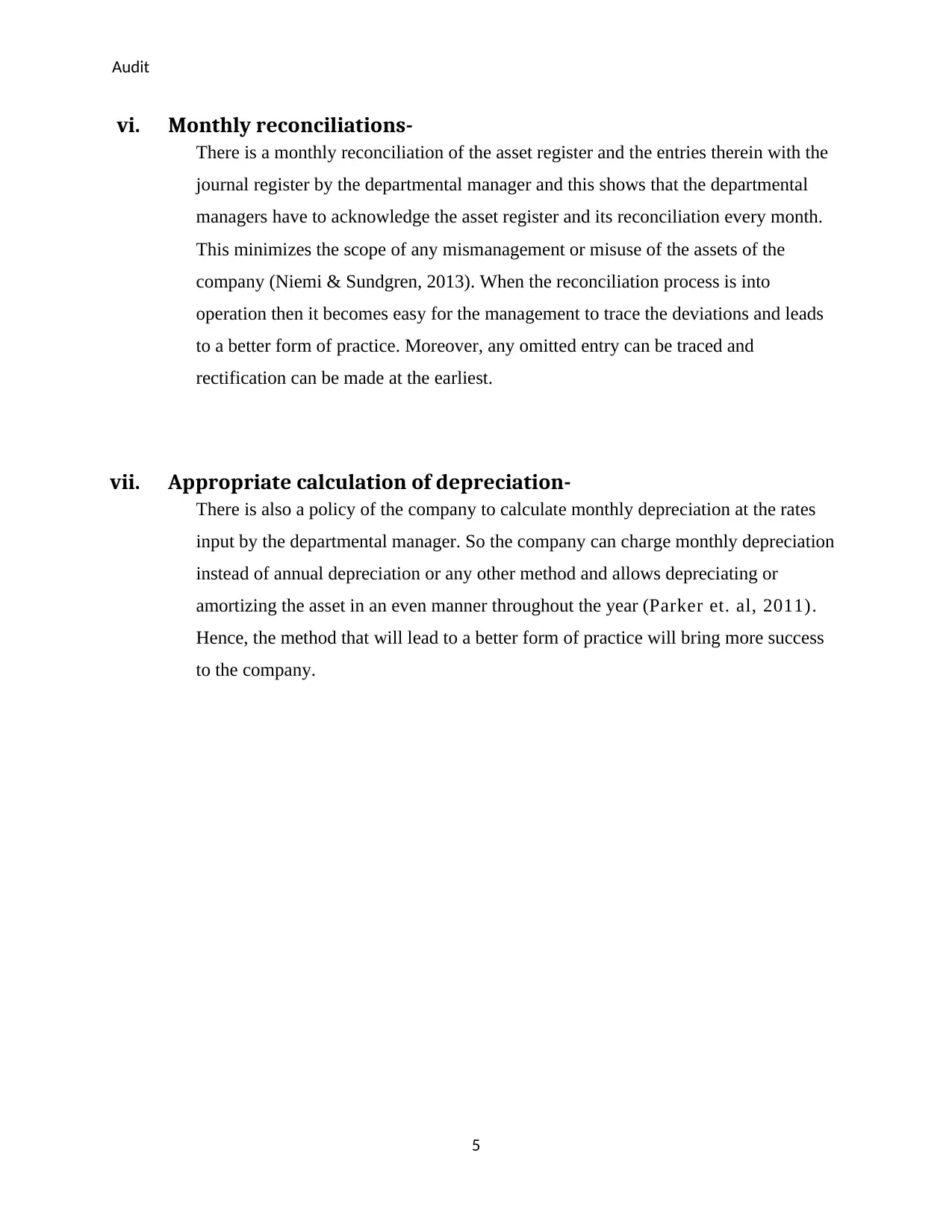
Audit
vi. Monthly reconciliations-
There is a monthly reconciliation of the asset register and the entries therein with the
journal register by the departmental manager and this shows that the departmental
managers have to acknowledge the asset register and its reconciliation every month.
This minimizes the scope of any mismanagement or misuse of the assets of the
company (Niemi & Sundgren, 2013). When the reconciliation process is into
operation then it becomes easy for the management to trace the deviations and leads
to a better form of practice. Moreover, any omitted entry can be traced and
rectification can be made at the earliest.
vii. Appropriate calculation of depreciation-
There is also a policy of the company to calculate monthly depreciation at the rates
input by the departmental manager. So the company can charge monthly depreciation
instead of annual depreciation or any other method and allows depreciating or
amortizing the asset in an even manner throughout the year (Parker et. al, 2011).
Hence, the method that will lead to a better form of practice will bring more success
to the company.
5
vi. Monthly reconciliations-
There is a monthly reconciliation of the asset register and the entries therein with the
journal register by the departmental manager and this shows that the departmental
managers have to acknowledge the asset register and its reconciliation every month.
This minimizes the scope of any mismanagement or misuse of the assets of the
company (Niemi & Sundgren, 2013). When the reconciliation process is into
operation then it becomes easy for the management to trace the deviations and leads
to a better form of practice. Moreover, any omitted entry can be traced and
rectification can be made at the earliest.
vii. Appropriate calculation of depreciation-
There is also a policy of the company to calculate monthly depreciation at the rates
input by the departmental manager. So the company can charge monthly depreciation
instead of annual depreciation or any other method and allows depreciating or
amortizing the asset in an even manner throughout the year (Parker et. al, 2011).
Hence, the method that will lead to a better form of practice will bring more success
to the company.
5
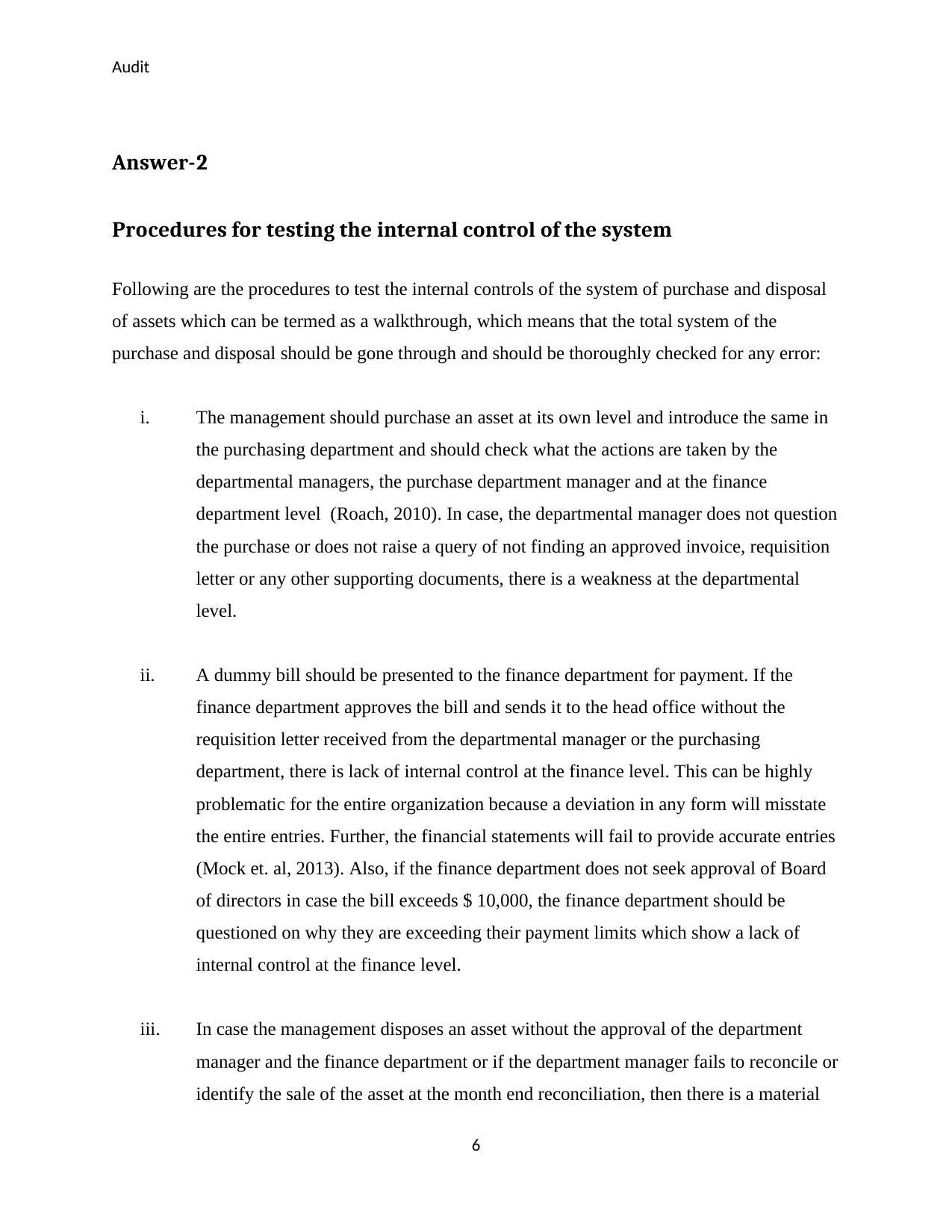
Audit
Answer-2
Procedures for testing the internal control of the system
Following are the procedures to test the internal controls of the system of purchase and disposal
of assets which can be termed as a walkthrough, which means that the total system of the
purchase and disposal should be gone through and should be thoroughly checked for any error:
i. The management should purchase an asset at its own level and introduce the same in
the purchasing department and should check what the actions are taken by the
departmental managers, the purchase department manager and at the finance
department level (Roach, 2010). In case, the departmental manager does not question
the purchase or does not raise a query of not finding an approved invoice, requisition
letter or any other supporting documents, there is a weakness at the departmental
level.
ii. A dummy bill should be presented to the finance department for payment. If the
finance department approves the bill and sends it to the head office without the
requisition letter received from the departmental manager or the purchasing
department, there is lack of internal control at the finance level. This can be highly
problematic for the entire organization because a deviation in any form will misstate
the entire entries. Further, the financial statements will fail to provide accurate entries
(Mock et. al, 2013). Also, if the finance department does not seek approval of Board
of directors in case the bill exceeds $ 10,000, the finance department should be
questioned on why they are exceeding their payment limits which show a lack of
internal control at the finance level.
iii. In case the management disposes an asset without the approval of the department
manager and the finance department or if the department manager fails to reconcile or
identify the sale of the asset at the month end reconciliation, then there is a material
6
Answer-2
Procedures for testing the internal control of the system
Following are the procedures to test the internal controls of the system of purchase and disposal
of assets which can be termed as a walkthrough, which means that the total system of the
purchase and disposal should be gone through and should be thoroughly checked for any error:
i. The management should purchase an asset at its own level and introduce the same in
the purchasing department and should check what the actions are taken by the
departmental managers, the purchase department manager and at the finance
department level (Roach, 2010). In case, the departmental manager does not question
the purchase or does not raise a query of not finding an approved invoice, requisition
letter or any other supporting documents, there is a weakness at the departmental
level.
ii. A dummy bill should be presented to the finance department for payment. If the
finance department approves the bill and sends it to the head office without the
requisition letter received from the departmental manager or the purchasing
department, there is lack of internal control at the finance level. This can be highly
problematic for the entire organization because a deviation in any form will misstate
the entire entries. Further, the financial statements will fail to provide accurate entries
(Mock et. al, 2013). Also, if the finance department does not seek approval of Board
of directors in case the bill exceeds $ 10,000, the finance department should be
questioned on why they are exceeding their payment limits which show a lack of
internal control at the finance level.
iii. In case the management disposes an asset without the approval of the department
manager and the finance department or if the department manager fails to reconcile or
identify the sale of the asset at the month end reconciliation, then there is a material
6
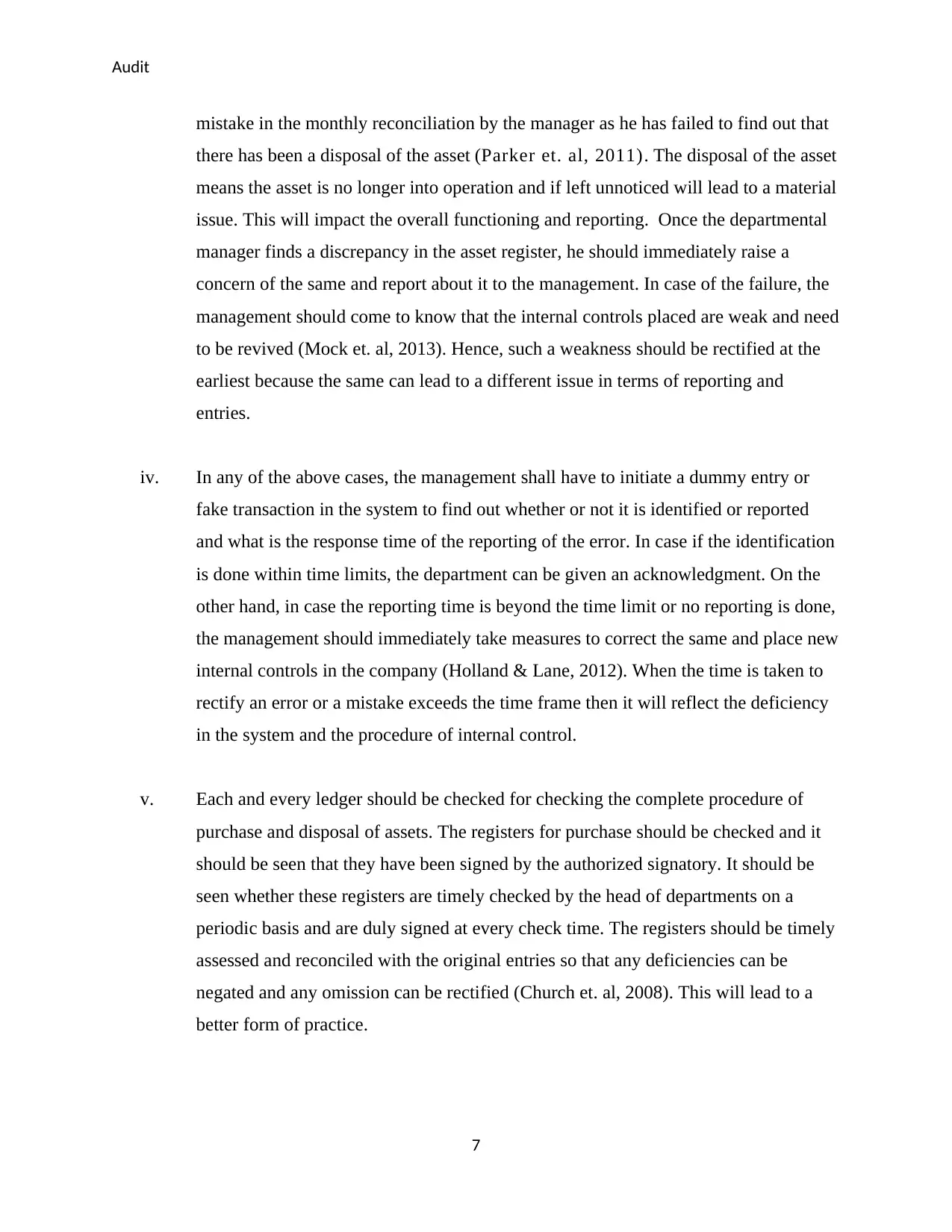
Audit
mistake in the monthly reconciliation by the manager as he has failed to find out that
there has been a disposal of the asset (Parker et. al, 2011). The disposal of the asset
means the asset is no longer into operation and if left unnoticed will lead to a material
issue. This will impact the overall functioning and reporting. Once the departmental
manager finds a discrepancy in the asset register, he should immediately raise a
concern of the same and report about it to the management. In case of the failure, the
management should come to know that the internal controls placed are weak and need
to be revived (Mock et. al, 2013). Hence, such a weakness should be rectified at the
earliest because the same can lead to a different issue in terms of reporting and
entries.
iv. In any of the above cases, the management shall have to initiate a dummy entry or
fake transaction in the system to find out whether or not it is identified or reported
and what is the response time of the reporting of the error. In case if the identification
is done within time limits, the department can be given an acknowledgment. On the
other hand, in case the reporting time is beyond the time limit or no reporting is done,
the management should immediately take measures to correct the same and place new
internal controls in the company (Holland & Lane, 2012). When the time is taken to
rectify an error or a mistake exceeds the time frame then it will reflect the deficiency
in the system and the procedure of internal control.
v. Each and every ledger should be checked for checking the complete procedure of
purchase and disposal of assets. The registers for purchase should be checked and it
should be seen that they have been signed by the authorized signatory. It should be
seen whether these registers are timely checked by the head of departments on a
periodic basis and are duly signed at every check time. The registers should be timely
assessed and reconciled with the original entries so that any deficiencies can be
negated and any omission can be rectified (Church et. al, 2008). This will lead to a
better form of practice.
7
mistake in the monthly reconciliation by the manager as he has failed to find out that
there has been a disposal of the asset (Parker et. al, 2011). The disposal of the asset
means the asset is no longer into operation and if left unnoticed will lead to a material
issue. This will impact the overall functioning and reporting. Once the departmental
manager finds a discrepancy in the asset register, he should immediately raise a
concern of the same and report about it to the management. In case of the failure, the
management should come to know that the internal controls placed are weak and need
to be revived (Mock et. al, 2013). Hence, such a weakness should be rectified at the
earliest because the same can lead to a different issue in terms of reporting and
entries.
iv. In any of the above cases, the management shall have to initiate a dummy entry or
fake transaction in the system to find out whether or not it is identified or reported
and what is the response time of the reporting of the error. In case if the identification
is done within time limits, the department can be given an acknowledgment. On the
other hand, in case the reporting time is beyond the time limit or no reporting is done,
the management should immediately take measures to correct the same and place new
internal controls in the company (Holland & Lane, 2012). When the time is taken to
rectify an error or a mistake exceeds the time frame then it will reflect the deficiency
in the system and the procedure of internal control.
v. Each and every ledger should be checked for checking the complete procedure of
purchase and disposal of assets. The registers for purchase should be checked and it
should be seen that they have been signed by the authorized signatory. It should be
seen whether these registers are timely checked by the head of departments on a
periodic basis and are duly signed at every check time. The registers should be timely
assessed and reconciled with the original entries so that any deficiencies can be
negated and any omission can be rectified (Church et. al, 2008). This will lead to a
better form of practice.
7
Paraphrase This Document
Need a fresh take? Get an instant paraphrase of this document with our AI Paraphraser
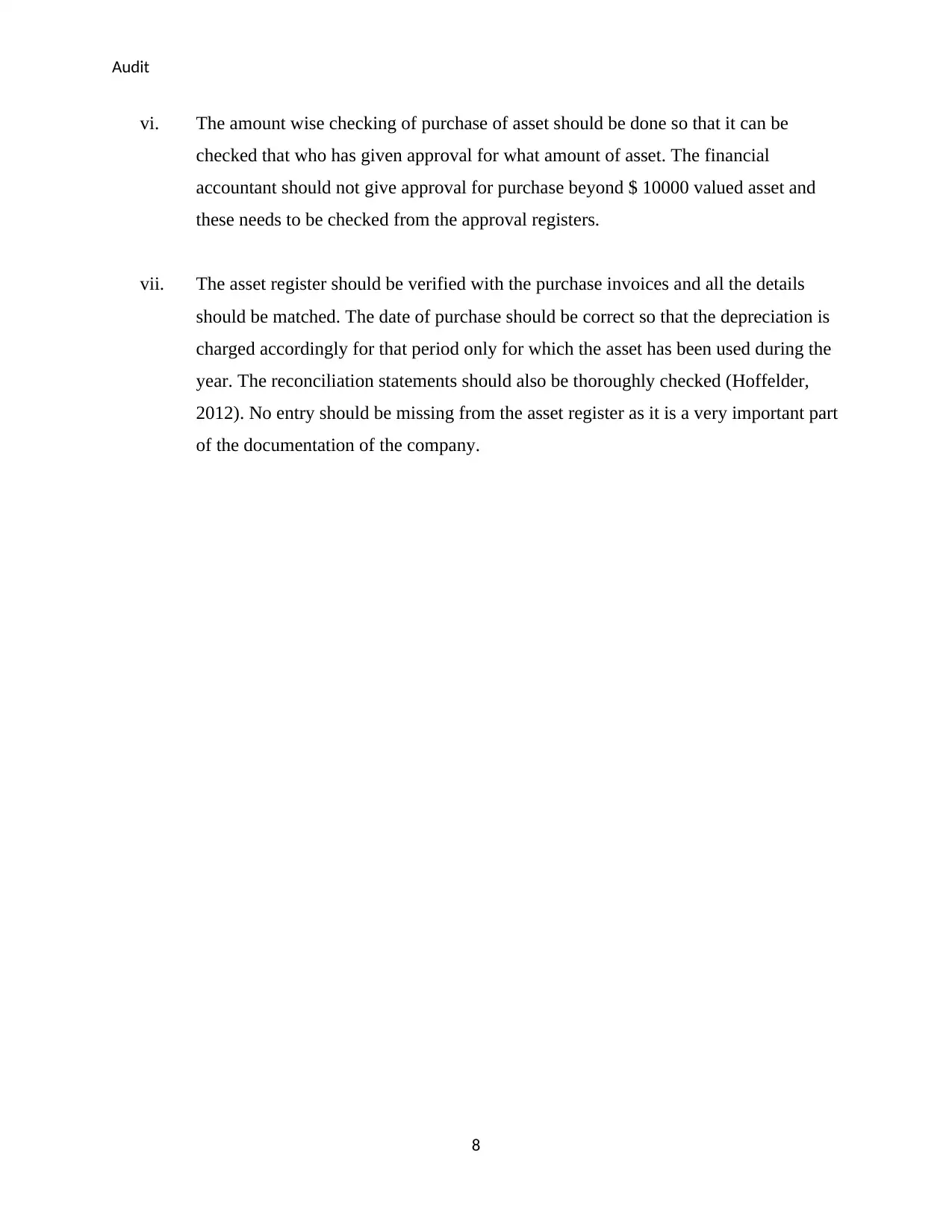
Audit
vi. The amount wise checking of purchase of asset should be done so that it can be
checked that who has given approval for what amount of asset. The financial
accountant should not give approval for purchase beyond $ 10000 valued asset and
these needs to be checked from the approval registers.
vii. The asset register should be verified with the purchase invoices and all the details
should be matched. The date of purchase should be correct so that the depreciation is
charged accordingly for that period only for which the asset has been used during the
year. The reconciliation statements should also be thoroughly checked (Hoffelder,
2012). No entry should be missing from the asset register as it is a very important part
of the documentation of the company.
8
vi. The amount wise checking of purchase of asset should be done so that it can be
checked that who has given approval for what amount of asset. The financial
accountant should not give approval for purchase beyond $ 10000 valued asset and
these needs to be checked from the approval registers.
vii. The asset register should be verified with the purchase invoices and all the details
should be matched. The date of purchase should be correct so that the depreciation is
charged accordingly for that period only for which the asset has been used during the
year. The reconciliation statements should also be thoroughly checked (Hoffelder,
2012). No entry should be missing from the asset register as it is a very important part
of the documentation of the company.
8
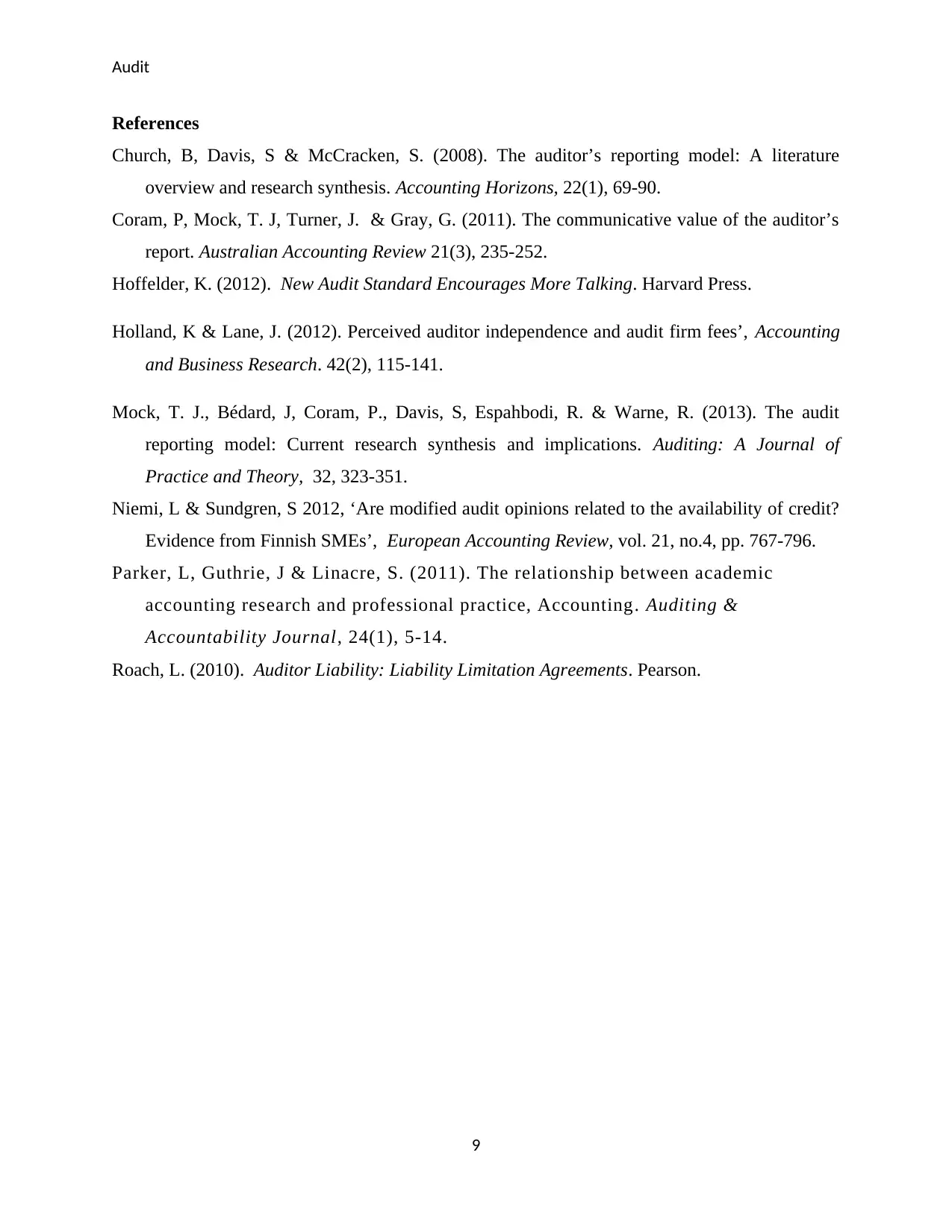
Audit
References
Church, B, Davis, S & McCracken, S. (2008). The auditor’s reporting model: A literature
overview and research synthesis. Accounting Horizons, 22(1), 69-90.
Coram, P, Mock, T. J, Turner, J. & Gray, G. (2011). The communicative value of the auditor’s
report. Australian Accounting Review 21(3), 235-252.
Hoffelder, K. (2012). New Audit Standard Encourages More Talking. Harvard Press.
Holland, K & Lane, J. (2012). Perceived auditor independence and audit firm fees’, Accounting
and Business Research. 42(2), 115-141.
Mock, T. J., Bédard, J, Coram, P., Davis, S, Espahbodi, R. & Warne, R. (2013). The audit
reporting model: Current research synthesis and implications. Auditing: A Journal of
Practice and Theory, 32, 323-351.
Niemi, L & Sundgren, S 2012, ‘Are modified audit opinions related to the availability of credit?
Evidence from Finnish SMEs’, European Accounting Review, vol. 21, no.4, pp. 767-796.
Parker, L, Guthrie, J & Linacre, S. (2011). The relationship between academic
accounting research and professional practice, Accounting . Auditing &
Accountability Journal, 24(1), 5-14.
Roach, L. (2010). Auditor Liability: Liability Limitation Agreements. Pearson.
9
References
Church, B, Davis, S & McCracken, S. (2008). The auditor’s reporting model: A literature
overview and research synthesis. Accounting Horizons, 22(1), 69-90.
Coram, P, Mock, T. J, Turner, J. & Gray, G. (2011). The communicative value of the auditor’s
report. Australian Accounting Review 21(3), 235-252.
Hoffelder, K. (2012). New Audit Standard Encourages More Talking. Harvard Press.
Holland, K & Lane, J. (2012). Perceived auditor independence and audit firm fees’, Accounting
and Business Research. 42(2), 115-141.
Mock, T. J., Bédard, J, Coram, P., Davis, S, Espahbodi, R. & Warne, R. (2013). The audit
reporting model: Current research synthesis and implications. Auditing: A Journal of
Practice and Theory, 32, 323-351.
Niemi, L & Sundgren, S 2012, ‘Are modified audit opinions related to the availability of credit?
Evidence from Finnish SMEs’, European Accounting Review, vol. 21, no.4, pp. 767-796.
Parker, L, Guthrie, J & Linacre, S. (2011). The relationship between academic
accounting research and professional practice, Accounting . Auditing &
Accountability Journal, 24(1), 5-14.
Roach, L. (2010). Auditor Liability: Liability Limitation Agreements. Pearson.
9
1 out of 9
Related Documents
Your All-in-One AI-Powered Toolkit for Academic Success.
+13062052269
info@desklib.com
Available 24*7 on WhatsApp / Email
![[object Object]](/_next/static/media/star-bottom.7253800d.svg)
Unlock your academic potential
© 2024 | Zucol Services PVT LTD | All rights reserved.
